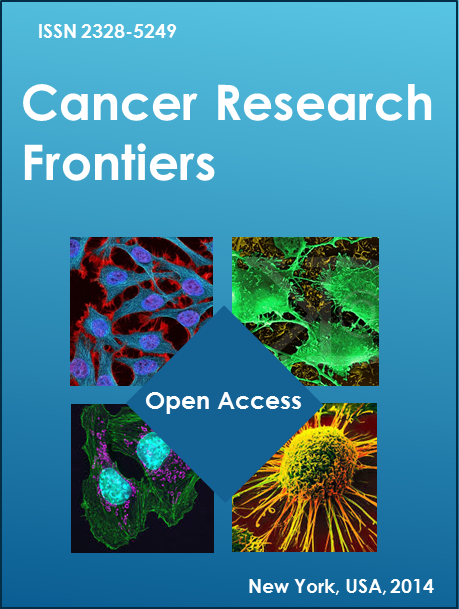Abstract _ Full Text (HTML) _ Full Text (PDF)
Case Report
Cancer Research Frontiers. 2016 Sept; 2(3): 427-431. doi: 10.17980/2016.427
Whipple’s Procedure Complicated by Celiac Artery Stenosis: Case Report and Review of Treatment Options
Konstantinos Bramis1, Georgios Kourounis2,3, Patrick (Paul) Tabet3,4*, Dementrios Moris5, Athanasios Petrou6
1 First Department of Propaedeutic Surgery, University of Athens Medical School, Laiko Athens General Hospital, Agiou Thoma Road, Goudi Athens, Greece
2 Dumfries and Galloway Royal Infirmary, Bankend Rd, Dumfries, UK.
3 University of Edinburgh, Old College, South Bridge, Edinburgh, UK
4 King George hospital, Barley Ln, Goodmayes, Ilford, UK
5 Lerner Research Institute, Cleveland Clinic Foundation, 9620 Carnegie Ave, Cleveland, OH, USA
6 New Nicosia General Hospital, 215 Limassol Old Road, Strovolos, Nicosia, Cyprus; St George’s University of London Programme, University of Nicosia, 93 Agiou Nikolaou Street, Engomi, Nicosia, Cyprus
*Corresponding author: Dr Patrick Paul Tabet, King George hospital, Barley Ln, Goodmayes, Ilford, UK; University of Edinburgh, Old College, South Bridge, Edinburgh, UK. Email:
Citation: Konstantinos Bramis, et al. Whipple’s Procedure Complicated by Celiac Artery Stenosis: Case Report and Review of Treatment Options. Cancer Research Frontiers. 2016 Sept; 2(3): 427-431. doi: 10.17980/2016.427
Copyright: @ 2016 Konstantinos Bramis, et al. This is an open-access article distributed under the terms of the Creative Commons Attribution License, which permits unrestricted use, distribution, and reproduction in any medium, provided the original author and source are credited.
Competing Interests: The authors declare no competing financial interests.
Received Oct 21, 2016; Revised Dec 8, 2016; Accepted Jan 7, 2017. Published Jan 13, 2017
Abstract
Although infrequently symptomatic, celiac artery stenosis is a vascular pathology that can commonly be encountered in hepatobiliary surgery. Secondary to celiac artery stenosis, the supramesocolic viscera may rely on blood supply from the gastroduodenal artery which, if ligated, can lead to detrimental ischaemia causing postoperative morbidity and mortality. We report the case of a 53-year-old female scheduled to have a pancreaticoduodenectomy and an asymptomatic extrinsic celiac artery stenosis identified during preoperative imaging workup. The stenosis was significant, with confirmed retrograde flow in the gastroduodenal artery. Pre-operative endovascular management was considered, but surgical management was preferred due to the young age of the patient and the non-atherosclerotic nature of the stenosis. In conclusion, the release of extrinsic compression on the celiac artery lead to a safer and less complicated procedure, eliminating the need for vascular reconstruction or endovascular intervention.
Key words: Celiac artery stenosis; pancreaticoduodenectomy; Whipple procedure; pancreatic neoplasms.
Introduction
Celiac artery stenosis (CAS) is a relatively common entity, but only rarely symptomatic. It has been reported in various studies to be in the range of 4%-20% in the older general population, and 2%-7,6% of patients undergoing pancreaticoduodenectomy [1, 2, 3]. CAS is usually asymptomatic due to rich collateral anastomotic networks between the celiac artery (CA) and superior mesenteric artery (SMA). This network mostly comprises of the pancreaticoduodenal arcades formed by the superior and inferior pancreaticoduodenal arteries as well as the dorsal pancreatic artery from the splenic artery [4]. In cases of CAS, common hepatic artery (CHA) branches are fed through retrograde flow via the gastroduodenal artery (GDA). Ligation of GDA during pancreaticoduodenectomy therefore can lead to irreversible ischaemic damage of the supramesocolic viscera including the liver and pancreas. Hence, postoperative morbidity and mortality might be increased due to decreased blood flow and ischaemic changes that could lead to anastomotic dehiscence and leaks. CAS was usually diagnosed intraoperatively by performing certain maneuvers like the GDA occlusion test described by Bull et al [5], and Doppler of the common hepatic artery. Nowadays, cases are frequently diagnosed preoperatively as an incidental finding on staging scans. We report a case of celiac artery compression in a patient scheduled to have pancreaticoduodenectomy and a brief review of the literature regarding treatment options.
Table 1: Treatment options available for patients with celiac artery stenosis undergoing a pancreaticoduodenectomy
Case presentation
This is the case of a 53-year-old female who presented to our hospital with a urinary tract infection. Following a CT urogram, a mass lesion in the head of the pancreas was incidentally found. Apart from a minor mitral valve prolapse, she had an unremarkable past medical history. She denied any symptoms associated with the pancreatic mass.
As part of her preoperative work up, the patient underwent endoscopic ultrasound and contrast CT scan of the pancreas. In addition to revealing a complex mass in the head of the pancreas, the investigations also demonstrated a second incidental finding of tight CAS. A CT angiogram was performed (fig 1-A). CAS with retrograde filling of the GDA was then confirmed by a transarterial mesenteric angiogram. Vascular surgeons and interventional radiologists were then consulted about the case. As there was significant obstruction in addition to retrograde flow in the GDA, pre-operative endovascular management was considered. However, surgical management was deemed preferable due to the patient’s young age and the non-atherosclerotic nature of the CAS.
Operatively, the aorta and celiac axis were dissected, as well as its branches. Fibrous tissue was also present adjacent the celiac artery resulting in narrowing and kinking of the vessel. Retrograde flow of the GDA was operatively confirmed by occluding the GDA and noticing a reduction in the pulsation of the hepatic artery. Upon dissection of the fibrous tissue surrounding the celiac artery, the vessel was released with no visibly remaining stenosis. Confirmation of this was achieved by retrograde insertion of a dilator through the GDA. No further arterial reconstruction was performed as satisfactory flow through the celiac artery was also confirmed by temporarily occluding all the branches and venting through the GDA. A pylorus preserving pancreaticoduodenectomy was then performed.
Postoperatively the patient recovered without any major complications, apart from a prolonged ileus. A postoperative CT revealed resolution of the CAS (fig 1-B), and histology of the mass revealed a benign solid pseudo-papillary tumour of the pancreas. The patient was discharged home on the 22nd postoperative day.
Figure 1: Pre and postoperative CT scanning of the abdomen showing the resolution of the stenosis following the surgical intervention. A: Preoperative sagittal CT angiography demonstrating severe extrinsic compression of the celiac artery, one cm from its origin. The aorta being free from atherosclerosis, suggesting in this relatively young patient the diagnosis of median arcuate ligament syndrome. B: The postoperative horizontal CT scan demonstrates resolution of the stenosis in the celiac artery (arrow).
Discussion
Etiology of CAS falls into one of three categories: 1) extrinsic stenosis (eccentric type) due to compression by the medial arcuate ligament or periarterial ganglionic tissue, 2) intrinsic stenosis (concentric type) due to atherosclerotic disease, and 3) other rare causes including neoplastic disease, acute or chronic dissection, and external compression by an inflamed pancreas, or vascular injury. In western countries, according to a study by Berney et al [1], the most common cause of CAS is atherosclerosis (87%).
The presence of CAS does not always necessitate treatment since stenosis is usually asymptomatic because of collateral circulation between the celiac axis and superior mesenteric artery. Nevertheless, when pancreaticoduodenectomy is undertaken and collateral circulation is interrupted, ischemic sequelae may ensue. In light of this, regardless of all previous workup and results, a simple GDA occlusion test should always be undertaken to rule out low flow in the hepatic artery. In view of the limited literatureit is still unclear which is the best management of celiac axis stenosis in a patient undergoing pancreaticoduodenectomy, as multiple considerations are to be taken when evaluating the correct course of action.
If the stenosis is discovered preoperatively, one option is endovascular stenting (table 1) of the celiac axis. Success rates of this technique range in the literature between 80%-and 95% [6, 7, 8]. Long term results are still lacking. This treatment option may be particularly effective in cases of intrinsic stenosis due to ostial atherosclerosis. Complications associated with this option include restenosis, dislocation, and thrombosis of the stent as well as the potential for increased bleeding risk associated with the antiplatelet therapy that would be required. Gloviczki et al [9] alsoreported a case of CAS stent-crushing. An alternative method in treating CAS when this is diagnosed preoperatively is balloon dilatation (table 1), however due to unpredictable results, endovascular stenting is preferable [6, 7].
If a decision has been made for operative revascularization or if the stenosis is discovered during the operation, the options include reimplantation of the celiac axis to the aorta or arterial bypass grafting which is probably the most common option [8, 9], (table 1). Bypass between aorta and the celiac artery tributaries (most commonly, the hepatic artery) is usually performed with autologous venous graft (saphenous, external jugular) or prosthetic graft like polytetrafluoroethylene. Arterial bypass can also be constructed between the SMA and celiac artery tributaries. Arterial reimplantation can be used in cases of atherosclerotic disease and ostial obstruction of the celiac artery. We have reported the excision of a stenosed celiac axis and direct reimplantation onto the aorta [10]. In an effort to preserve sufficient collaterals between the SMA and celiac axis, a GDA preserving pancreaticoduodenectomy could be attempted (table 1). This option has the advantage of avoiding revascularization. This operation though, is technically demanding and it cannot be employed in cases of suspected malignant disease [11].
When CAS is due to entrapment from the medial arcuate ligament or perivascular fibrous ganglionic tissue, as in our case, division of the fibers of the arcuate ligament and the periarterial tissue relieves obstruction and restores arterial flow [12], (table 1).
When considering that endovascular stenting will require the patient to on antiplatelet therapy potentially increasing the operative risk of bleeding, as well as the increased mortality and morbidity associated with arterial reimplantation or bypass [8, 9]. Surgical decompression should be prioritized in patients due to undergo major procedures such as a pancreaticoduodenectomy where a CAS was identified preoperatively and found to be of extrinsic cause or of unclear etiology.
In our case, the exact cause of stenosis was not clear preoperatively. After division of fibers and decompression of the arcuate ligament the artery looked macroscopically normal and the stenosis appeared to have resolved. Hence, a metal dilator was passed through an arteriotomy in the GDA confirming that there was no residual stenosis in the celiac axis and blood freely flowed via the GDA.
Conclusion
Although relatively rare, CAS is a vascular pathology that could be encountered by general surgeons during pancreaticoduodenectomies. The successful management of CAS requires the surgeons to conduct meticulous preoperative radiological workup, as well as to get the participation of an experienced vascular team in the management. The majority of these cases are effectively managed by endovascular stenting prior to the pancreaticoduodenectomy, however if the CAS is diagnosed during the procedure, a surgical correction is required. It is of note that in young patients with CAS, surgical revascularization is the management option of choice. Finally, in eccentric type CAS, release of the extrinsic compression on the celiac artery allows for a less complicated procedure without the need for a risky vascular reconstruction, or an endovascular intervention.
Abbreviations
CA, celiac artery;
CAS, celiac artery stenosis;
CHA, common hepatic artery;
GDA, gastroduodenal artery
SMA, superior mesenteric artery
References
- Berney T, Pretre R, Chassot G, Morel P. The role of revascularization in celiac occlusion and pancreatoduodenectomy. Am J Surg 1998 Oct;176(4):352-6.
- Pfeiffenberger J, Adam U, Drognitz O, Kroger JC, Makowiec F, Schareck W, et al. Celiac axis stenosis in pancreatic head resection for chronic pancreatitis. Langenbecks Arch Surg 2002 Oct;387(5-6):210-5. doi: 10.1007/s00423-002-0310-1
- Trede M. The surgical treatment of pancreatic carcinoma. Surgery. 1985 97:28-35.
- Sakorafas GH, Sarr MG, Peros G. Celiac artery stenosis: an underappreciated and unpleasant surprise in patients undergoing pancreaticoduodenectomy. J Am Coll Surg. 2008 Feb;206(2):349-56. doi: 10.1016/j.jamcollsurg.2007.09.002.
- Bull DA, Hunter GC, Crabtree TG, Bernhard VM, Putnam CW. Hepatic ischaemia, caused by celiac axis compression, complicating pancreaticoduodenectomy. Ann Surg 1993 Mar;217(3):244-7 .
- Matsumoto AH, Angle JF, Spinosa DJ, et al. Percutaneous transluminal angioplasty and stenting in the treatment of chronic mesenteric ischemia: results and long-term follow-up. J Am Coll Surg. 2002 Jan;194(1 Suppl):S22-31.
- Matsumoto AH, Tegtmeyer CJ, Fitzcharles EK, Selby JB, Tribble CG, Angle JF, et al. Percutaneous transluminal angioplasty of visceral arterial stenoses: results and long-term clinical follow-up. J Vasc Interv Radiol. 1995 Mar-Apr;6(2):165-74.
- Kohn G, Bitar R, Farber M, Marston W, Overby W, Farrell T. Treatment Options and Outcomes for Celiac Artery Compression Syndrome. Surg Innov 2011 Dec;18(4):338-43. doi: 10.1177/1553350610397383
- Gloviczki P, Dunkan AA. Treatment of celiac artery compression syndrome: does it really exist? Perspect Vasc Surg Endovasc Ther 2007 Sep;19(3):259-63. doi: 10.1177/1531003507305263
- Soonawalla Z, Ganeshan A, Friend P. Celiac artery occlusion encountered during pancreatic resection: a case report. Ann R Coll Surg Engl 2007 Jan;89(1):W15-7. doi: 10.1308/147870807X160344
- Nagai H, Ohki J, Kondo Y, Yasuda T, Kasahara K, Kanazawa K. Pancreatoduodenectomy with preservation of the pylorus and gastroduodenal artery. Ann Surg 1996 Feb;223(2):194-8.
- Grotemeyer D, Duran M, Iskandar F, Nguyen K, Sandmann W. Median arcuate ligament syndrome: vascular surgical therapy and follow-up of 18 patients. Arch Surg 2009 Nov;394(6):1085-92. doi: 10.1007/s00423-009-0509-5.










